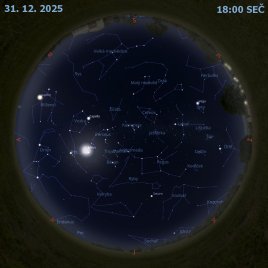M27: Mlhovina Činka

Uznání a copyright: Christopher Stobie
Takhle dopadne naše Slunce? Dost možná. První náznak budoucnosti našeho Slunce byl nechtěně objeven v roce 1764. V té době Charles Messier sestavoval seznam difúzních objektů, aby se nepletly s kometami. Sedmadvacátý objekt na Messierově seznamu, dnes známý jako M27 neboli mlhovina Činka, je planetární mlhovina, jedna z nejjasnějších planetárních mlhovin na obloze viditelná dalekohledem v souhvězdí Lištičky (Vulpecula). Světlu to k nám z M27 trvá asi 1000 let a zde je vidět v barvách vyzařovaných sírou (červená), vodíkem (zelená) a kyslíkem (modrá). Nyní víme, že přibližně za 6 miliard let naše Slunce odvrhne svou vrstvu vnějších plynů do planetární mlhoviny jako M27, zatímco jeho zbývající střed se stane rentgenovým horkým bílým trpaslíkem. Pochopení fyziky a významu M27 však bylo daleko za hranicemi vědy 18. století. I dnes zůstává mnoho záhadných věcí o planetárních mlhovinách, včetně toho, jak vznikají jejich spletité tvary.
Seznam odkazů v popisu
- NASA: The Sun
- Wikipedia: 1764
- Wikipedia: Charles_Messier
- SeaSky.org: The Messier Catalog of Deep Sky Objects
- APOD: 2008-06-26 M27 není kometa
- APOD: Planetary nebulae
- Wikipedia: Planetary_nebula
- NASA: What Are Constellations?
- Wikipedia: Vulpecula
- Instagram.com: stobiewankenobi.space: Dumbbell Nebula (M27)
- StarTools.org: Popular narrowband composite colouring
- Youtu.be: Sulfur - The SMELLIEST Element ON EARTH!
- Wikipedia: H-alpha
- LANL.gov: Oxygen
- APOD: 2018-09-26 Sluneční spektrum s chybějícími barvami
- Wikipedia: Sun#After_core_hydrogen_exhaustion
- Wikipedia: Planetární_mlhovina#Morfologie
- NASA: X-Rays
- APOD: 2000-09-10 Chládnutí bílých trpaslíků
- APOD: 2024-10-05 M27: Nekometa
- PinImg.com: Foto: tři psi s hlavou nakřivo :-)
- APOD: 2023-04-16 M2 9: Křídla Motýlí mlhoviny
- Wikipedia: Planetary_nebula#Current_issues_in_planetary_nebula_studies
- APOD: 2021-04-25 Planetární mlhovina Mz3: Mravenec
- APOD: 2020-07-21 Železo z mlhoviny Motýl
NASA Official: Phillip Newman Specific rights apply. NASA Web Privacy Policy and Important Notices
A service of: ASD at NASA / GSFC & Michigan Tech. U.
Odkaz na originální APOD


